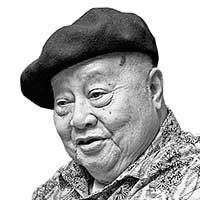Kamlon and Sabah

While writing about the Hukbalahap rebellion the other week, I brought to mind another significant uprising in the South. In Sulu, Hadji Kamlon mounted a rebellion, with a core group of not more than a hundred members. He has since then been regarded as a kind of folk hero among the Tausugs, the biggest tribal group in the Sulu archipelago. I was not able to see him, although I stayed in Sulu for almost a month.
Hadji Kamlon knew his territory very well. The island then, except for the small towns and the capital, Jolo, was all jungle. I visited Luuk where Constabulary Col. Mamarinta Lao had his headquarters, a lot of the Constabulary troops at the time were Moros, and Col. Lao himself was a Maranao. He told me it was difficult to locate Kamlon and his men, for not only the jungle was their comfortable redoubt. Many of the Tausugs aside from being relatives sympathized with him and no one would betray him.
The Navy had the island surrounded but it was easy for the Tausugs to slip out of the porous blockade. The Kamlon rebellion lasted more than a decade with breaks, surrender to Ramon Magsaysay, then back to the jungle and surrender again, court trial and life imprisonment and eventual pardon by president Marcos. When the Portuguese went there before the Spaniards did, they found the cannons forged in the foundries of Sulu were bigger and better than theirs. In the fifties, I saw these beautifully crafted weapons, the kris, the kampilan and the barong. There are no more. Whatever happened to the superior metallurgical skills of the Tausugs?
My first experience of Sulu was an eye opener. I started going to the other parts of Mindanao, to Tawi-Tawi, to exotic places like Siasi, Simunul, Sitangkai and luxuriated in their beautiful beaches and crystalline waters. The Kamlon uprising was related to the Sulu Sultanate claim on North Borneo (Sabah). This was explained to me by Princess Tarhata Kiram, who I met in Jolo together with her cousin, Sultan Ishmael Jamalul Kiram. I was the Sultan’s guest for a few days in his “palace” in Maimbung – actually a sprawling nipa house. Princess Tarhata, educated in the United States, was married to a retired Army officer. She was very fair, petite, charming and exuberant compared to the Sultan, who was tall and slim and quite dark and also very reserved in his manner and speech. Princess Tarhata’s great grandfather leased in perpetuity North Borneo to the English merchants, Baron de Overbeck and Alfred Dent, in 1878 and in 1881, it became British Chartered Company. In 1946 it became a British colony. A look at the map illustrates how close Sabah is to the Philippines. All through history, the natives of Sulu had moved freely to Sabah and traded with the territory, more than with any region in the country.
We must go back a little in our history, how Rizal planned to settle in North Borneo and start a colony. If I remember right, shortly after our independence in 1946, when the British turned over to the Philippine government the Turtle islands near North Borneo, the British North Borneo Company also invited Filipinos to settle there. I don’t think that invitation was entertained; at the time so much of the country especially in Mindanao was still jungle, our population not more than 25 million.
As with the East India Company which became India, the British North Borneo Company became a state of Malaysia when Malaysia became a nation. Past administrations have ignored our rightful claim to Sabah but last fortnight Foreign Affairs Secretary Teodoro Locsin Jr. revived the claim.
Sabah is one of those landmines that the British left behind when their empire was dismantled. Among these travel spots today are Kashmir in the Indian sub-continent which is contested by India and Pakistan, the other is Palestine in the Middle East, with the Palestinians suffering occupation by Israel.
On my visit to Sulu I first met the young Air Force officer, Eddie Martelino, who later on became a Muslim. He was tall, amiable and extremely intelligent. He used to visit me in the Manila Times because both of us were interested in North Borneo and in Southeast Asian regionalism. We must remember that at the time, we were the richest, most modern country in Southeast Asia, next to Japan, but had little knowledge and interaction with our neighbors. I told Eddie facetiously, paraphrasing Hitler when he took over Sudetenland: “Today, North Borneo, tomorrow Southeast Asia.” Eddie wrote a book on Southeast Asia whose draft I discussed with him. I did not know till it was front page news that he was responsible for setting up a sub-rosa organization to infiltrate Sabah. Something awry happened; the recruits who were training in Corregidor were massacred, but one managed to escape to tell the story. Jabidah was discovered and destroyed. I think it was inevitable because Eddie was an extrovert and he liked to talk. If ever another clandestine attempt to get Sabah is organized, to assure the success, that effort must be composed only of Tausugs and led by a Tausug himself. I never saw Eddie again, I heard rumors that the Malaysians got hold of him and killed him, but retired Air Force general Loven Abadia said the Tausugs got him and tortured him before they killed him.
I visited Marawi when it was called Dansalan, the old towns of Tugaya and Taraka. Saw the traditional Maranaw houses with massive posts, witnessed the natives – not university dance troupes – perform the spectacular Singkil. I witnessed the Cotabato towns Tacurong and Marbel and Kapatagan in Lanao burgeon from the jungle; I was appalled at how the land was raped, saw the giant logs floated down the Agusan river for shipment to Japan. I realized that early, how indolence and the datu system hindered Moro economic and political mobility. I have come to the conclusion that there will be no end to the “Moro problem,” although Princess Tarhata said the solution is in bed – in the intermarriage of Christians and Moros and among the Moros themselves who are very clannish. They have the same rights like other Filipinos; in those regions which they dominate, they hold political power; with the new arrangements with the government, that power is strengthened. There is no military solution to our “Moro” problem. It is about land, ethnicity, NOT religion. Ethnic differences last a long, long time. I can only hope that it will not and will never be violent, and that the Marawi conflict is the last. Development and education will continue to modernize Mindanao, and more so when the Moros will feel they are not just Tausugs, Maranaws or Maguindanaos but Filipinos.
- Latest
- Trending





























